light Peugeot Partner 2016 Owner's Manual
[x] Cancel search | Manufacturer: PEUGEOT, Model Year: 2016, Model line: Partner, Model: Peugeot Partner 2016Pages: 260, PDF Size: 8.83 MB
Page 4 of 260

2
Contents
Partner-2-Vu_en_Chap00a_Sommaire_ed02-2015
Key 18
Remote control 18
Alarm
20
Doors
21
Rear roof flap
25
T
ailgate 26
Central locking
27
Instrument panel
28
Date and time
29
W
arning lamps
32
Fuel gauge
40
Coolant
40
Under-inflation detection
41
Service indicator
43
Lighting dimmer
44
Steering wheel
adjustment
45
Manual gearbox
45
Gear shift indicator
46
6-speed electronic
gearbox
47
Stop & Start
49
Starting and stopping
52
Hill start assist
53
Driving
recommendations
54Lighting
55
Wipers
58
Trip computer
60
Cruise control
61
Speed limiter
64
Heating /
Air conditioning
manual
67
digital
69
Demisting and defrosting
72
Front seats
74
Individual passenger
seat
75
Multi-Flex bench seat
76
Configurations
78
Front fittings
79
Courtesy lamps
81
Crew cab
82
Load space
84
Roof bars
86
Mirrors
87
Electric windows
89
3.
18-54
READY TO GO
5.
90-116
SAFETY
Exterior 5
Interior 6
left hand drive
6 right hand drive
7
Instruments and controls
8 left hand drive
8 right hand drive
1
1
Technical data - Maintenance
12
1.
4-14
OVERVIEW
Horn 90
Hazard warning lamps 90
Parking brake
90
Parking sensors
91
Reversing camera
93
Anti-lock braking
system (ABS)
94
EBA
94
ASR and DSC
95
Grip control
96
Active City Brake
98
Seat belts
102
Airbags
104
Carrying children
108
Deactivating the passenger's
front airbag
1
10
Recommended seats
1
13
Installation
1
14
4.
55-89
EASE OF USE and
COMFORT
2.
15-17
ECO-DRIVING
Environment 15
Eco-driving 16
The "Visual Search " (visual
index) section assists
you in finding the controls
and functions and their
associated page numbers
on the schematic outlines of
the vehicle.
Instruments and controls
left hand drive
13 right hand drive
14
Page 10 of 260
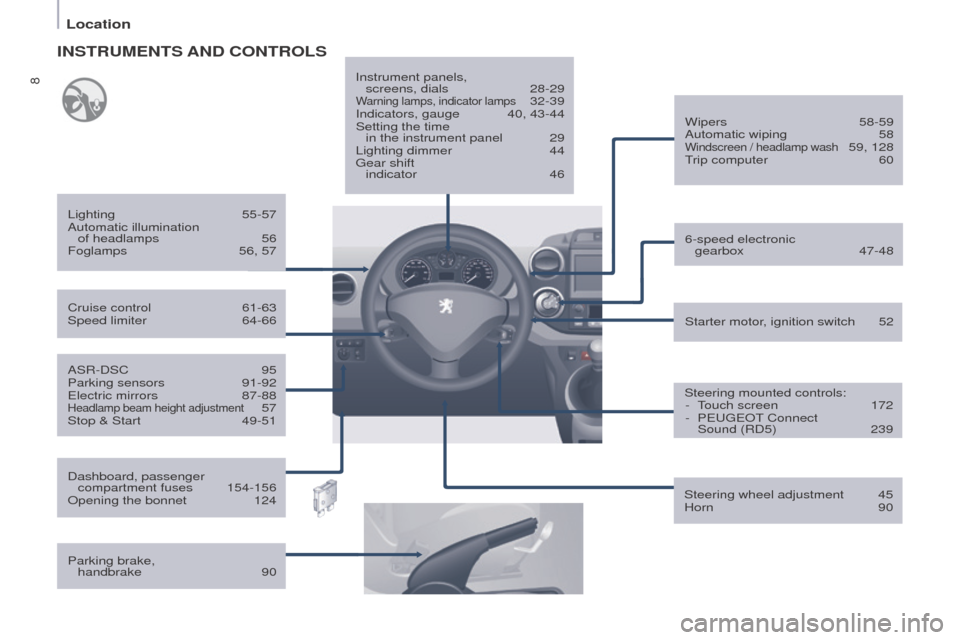
8
Location
Partner-2-Vu_en_Chap01_vue-ensemble_ed02-2015
ASR-DSC 95
Parking sensors 91-92
Electric mirrors
87-88Headlamp beam height adjustment 57
Stop & Start
49-51 Starter motor
, ignition switch
52
Wipers
58-59
Automatic wiping
58Windscreen / headlamp wash 59, 128
Trip computer
60
Cruise control
61-63
Speed limiter
64-66
Lighting
55-57
Automatic illumination
of headlamps
56
Foglamps
56, 57
INSTRUMENTS AND CONTROLS
Dashboard, passenger
compartment fuses 154-156
Opening the bonnet
124
Parking brake,
handbrake
90 Instrument panels,
screens, dials
28-29Warning lamps, indicator lamps 32-39
Indicators, gauge
40, 43-44
Setting the time
in the instrument panel
29
Lighting dimmer
44
Gear shift
indicator
46
Steering mounted controls:-
T
ouch screen
172
-
PEUGEOT
Connect
Sound (RD5)
239
Steering wheel adjustment
45
Horn
90
6-speed electronic
gearbox
47-48
Page 13 of 260
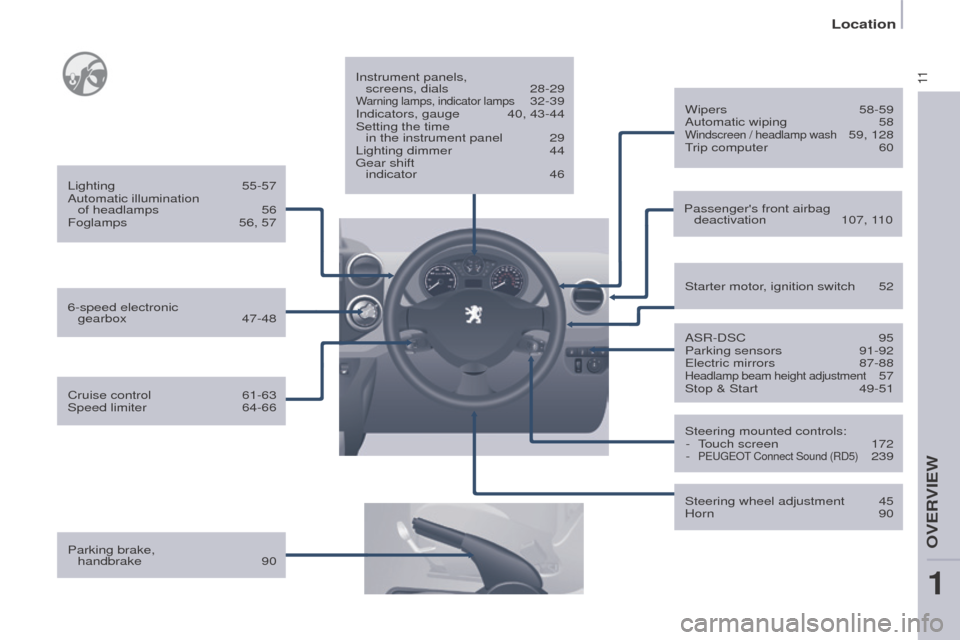
11
Location
Partner-2-Vu_en_Chap01_vue-ensemble_ed02-2015
Parking brake, handbrake 90 Instrument panels,
screens, dials
28-29Warning lamps, indicator lamps 32-39
Indicators, gauge
40, 43-44
Setting the time
in the instrument panel
29
Lighting dimmer
44
Gear shift
indicator
46 Passenger's front airbag deactivation
107, 1
10
ASR-DSC
95
Parking sensors
91-92
Electric mirrors
87-88Headlamp beam height adjustment 57
Stop & Start
49-51
Starter motor
, ignition switch
52
Wipers
58-59
Automatic wiping
58Windscreen / headlamp wash 59, 128
Trip computer
60
Steering mounted controls: -
T
ouch screen
172
-
PEUGEOT Connect Sound (RD5) 239
Steering wheel adjustment
45
Horn
90
6-speed electronic
gearbox
47-48
Lighting
55-57
Automatic illumination
of headlamps
56
Foglamps
56, 57
Cruise control
61-63
Speed limiter
64-66
1
OVERVIEW
Page 14 of 260

12
Location
Partner-2-Vu_en_Chap01_vue-ensemble_ed02-2015
TECHNICAL DATA - M AINTENANCE
Identification markings,
serial number, paint code,
tyres
168
Windscreen / headlamp wash, levels
128
Changing bulbs,
lighting
148-153 Checks
129-130
-
battery
,
-
brake pads,
-
brake drums, discs.
-
parking brake,
-
carbon/passenger compartment filter,- oil filter,
- particle filter ,
-
gearbox.
Emissions controls
41
Engine fuses
154, 157
Under the bonnet: -
Diesel
126
-
petrol
125
Fuel cut-of
f,
Diesel priming
132
AdBlue additive
133-139
Opening the bonnet, stay
124 Levels
127-128
-
dipstick,
-
brake fluid,
-
coolant.
-
power steering fluid,
-
Diesel additive,
Bleeding water
, Diesel filter
130
W
arning lamps
32-39
Snow chains
147
Dimensions
162-165
Floor cab dimensions
166
Engines / W
eights
167
Page 15 of 260
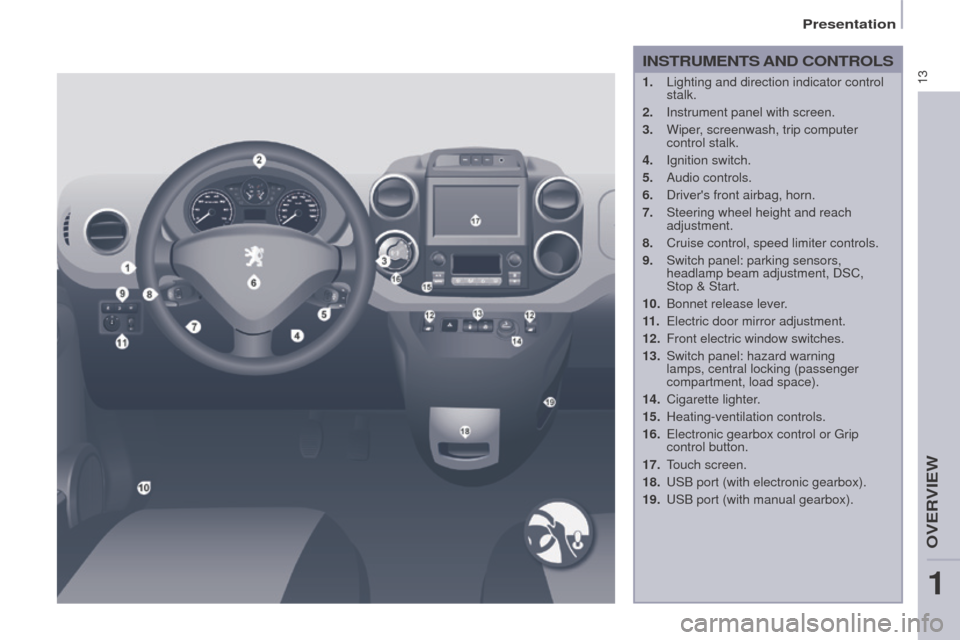
13
Partner-2-Vu_en_Chap01_vue-ensemble_ed02-2015
INSTRUMENTS AND CONTROLS
1. Lighting and direction indicator control
stalk.
2.
Instrument panel with screen.
3.
Wiper
, screenwash, trip computer
control stalk.
4.
Ignition switch.
5.
Audio controls.
6.
Driver's front airbag, horn.
7.
Steering wheel height and reach
adjustment.
8.
Cruise control, speed limiter controls.
9.
Switch panel: parking sensors,
headlamp beam adjustment, DSC,
Stop
& Start.
10.
Bonnet release lever
.
11 .
Electric door mirror adjustment.
12.
Front electric window switches.
13.
Switch panel: hazard warning
lamps, central locking (passenger
compartment, load space).
14.
Cigarette lighter
.
15.
Heating-ventilation controls.
16.
Electronic gearbox control or Grip
control button.
17.
T
ouch screen.
18.
USB port (with electronic gearbox).
19.
USB port (with manual gearbox).
1
OVERVIEW
Presentation
Page 16 of 260
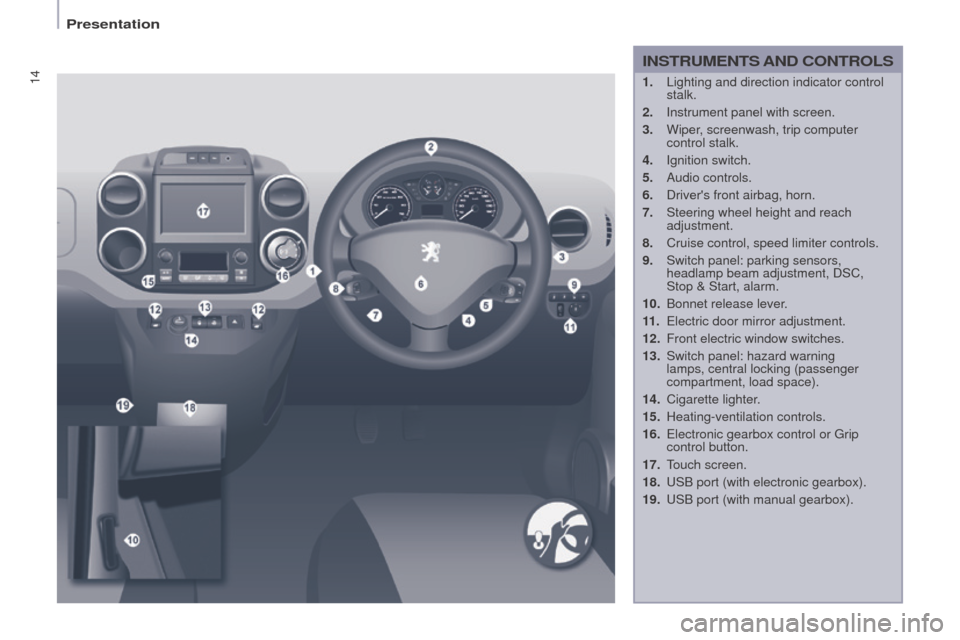
14
Partner-2-Vu_en_Chap01_vue-ensemble_ed02-2015
1. Lighting and direction indicator control
stalk.
2.
Instrument panel with screen.
3.
Wiper
, screenwash, trip computer
control stalk.
4.
Ignition switch.
5.
Audio controls.
6.
Driver's front airbag, horn.
7.
Steering wheel height and reach
adjustment.
8.
Cruise control, speed limiter controls.
9.
Switch panel: parking sensors,
headlamp beam adjustment, DSC,
Stop & Start, alarm.
10.
Bonnet release lever
.
11 .
Electric door mirror adjustment.
12.
Front electric window switches.
13.
Switch panel: hazard warning
lamps, central locking (passenger
compartment, load space).
14.
Cigarette lighter
.
15.
Heating-ventilation controls.
16.
Electronic gearbox control or Grip
control button.
17.
T
ouch screen.
18.
USB port (with electronic gearbox).
19.
USB port (with manual gearbox).
INSTRUMENTS AND CONTROLS
Presentation
Page 18 of 260
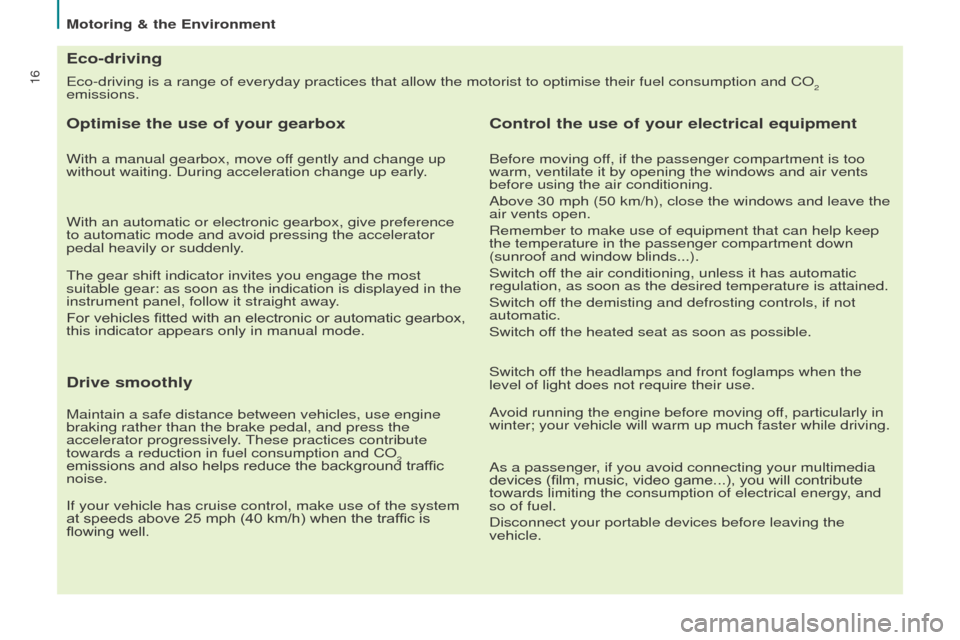
16
Motoring & the Environment
Eco-driving is a range of everyday practices that allow the motorist to \
optimise their fuel consumption and CO
2
emissions.
Eco-driving
Optimise the use of your gearbox
With a manual gearbox, move off gently and change up
without waiting. During acceleration change up early.
With an automatic or electronic gearbox, give preference
to automatic mode and avoid pressing the accelerator
pedal heavily or suddenly.
The gear shift indicator invites you engage the most
suitable gear: as soon as the indication is displayed in the
instrument panel, follow it straight away.
For vehicles fitted with an electronic or automatic gearbox,
this indicator appears only in manual mode.
Drive smoothly
Maintain a safe distance between vehicles, use engine
braking rather than the brake pedal, and press the
accelerator progressively. These practices contribute
towards a reduction in fuel consumption and CO
2
emissions and also helps reduce the background traffic
noise.
If your vehicle has cruise control, make use of the system
at speeds above 25 mph (40 km/h) when the traffic is
flowing well.
Control the use of your electrical equipment
Before moving off, if the passenger compartment is too
warm, ventilate it by opening the windows and air vents
before using the air conditioning.
Above 30 mph (50 km/h), close the windows and leave the
air vents open.
Remember to make use of equipment that can help keep
the temperature in the passenger compartment down
(sunroof and window blinds...).
Switch off the air conditioning, unless it has automatic
regulation, as soon as the desired temperature is attained.
Switch off the demisting and defrosting controls, if not
automatic.
Switch off the heated seat as soon as possible.
Switch off the headlamps and front foglamps when the
level of light does not require their use.
Avoid running the engine before moving off, particularly in
winter; your vehicle will warm up much faster while driving.
As a passenger, if you avoid connecting your multimedia
devices (film, music, video game...), you will contribute
towards limiting the consumption of electrical energy, and
so of fuel.
Disconnect your portable devices before leaving the
vehicle.
Page 20 of 260
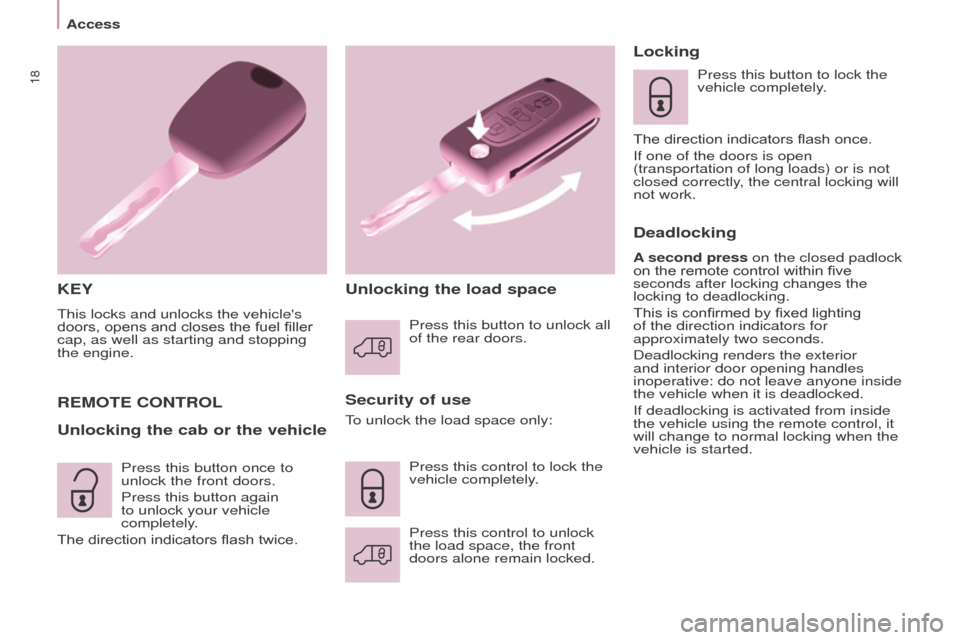
18
Access
Partner-2-Vu_en_Chap03_Pret-a-partir_ed02-2015
KEY
This locks and unlocks the vehicle's
doors, opens and closes the fuel filler
cap, as well as starting and stopping
the engine.
Security of use
R
EMOTE
CONTROL
Unlocking the cab or the vehicle Unlocking the load spaceLocking
Press this button to lock the
vehicle completely.
The direction indicators flash once.
If one of the doors is open
(transportation of long loads) or is not
closed correctly, the central locking will
not work.
Deadlocking
A second press on the closed padlock
on the remote control within five
seconds after locking changes the
locking to deadlocking.
This is confirmed by fixed lighting
of the direction indicators for
approximately two seconds.
Deadlocking renders the exterior
and interior door opening handles
inoperative: do not leave anyone inside
the vehicle when it is deadlocked.
If deadlocking is activated from inside
the vehicle using the remote control, it
will change to normal locking when the
vehicle is started.
To unlock the load space only:
Press this control to unlock
the load space, the front
doors alone remain locked. Press this control to lock the
vehicle completely. Press this button to unlock all
of the rear doors.
Press this button once to
unlock the front doors.
Press this button again
to unlock your vehicle
completely.
The direction indicators flash twice.
Page 22 of 260
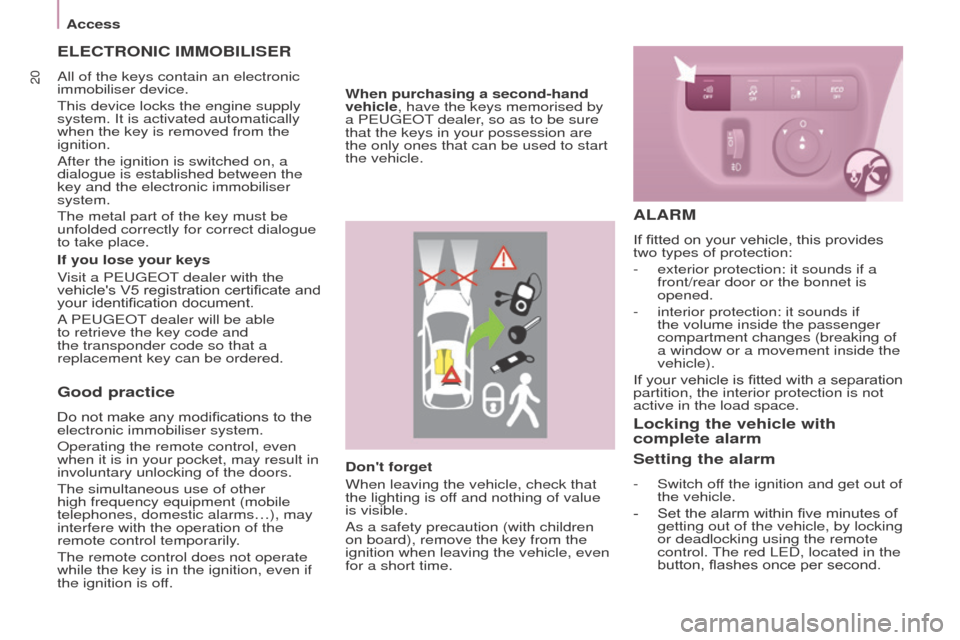
20
Access
Partner-2-Vu_en_Chap03_Pret-a-partir_ed02-2015
Good practice
Do not make any modifications to the
electronic immobiliser system.
Operating the remote control, even
when it is in your pocket, may result in
involuntary unlocking of the doors.
The simultaneous use of other
high frequency equipment (mobile
telephones, domestic alarms…), may
interfere with the operation of the
remote control temporarily.
The remote control does not operate
while the key is in the ignition, even if
the ignition is off.
ELECTRONIC IMMOBILISER
All of the keys contain an electronic
immobiliser device.
This device locks the engine supply
system. It is activated automatically
when the key is removed from the
ignition.
After the ignition is switched on, a
dialogue is established between the
key and the electronic immobiliser
system.
The metal part of the key must be
unfolded correctly for correct dialogue
to take place.
If you lose your keys
Visit a PEUGEOT dealer with the
vehicle's V5 registration certificate and
your identification document.
A PEUGEOT dealer will be able
to retrieve the key code and
the transponder code so that a
replacement key can be ordered.Don't forget
When leaving the vehicle, check that
the lighting is off and nothing of value
is visible.
As a safety precaution (with children
on board), remove the key from the
ignition when leaving the vehicle, even
for a short time.
When purchasing a second-hand
vehicle, have the keys memorised by
a PEUGEOT dealer, so as to be sure
that the keys in your possession are
the only ones that can be used to start
the vehicle.
ALARM
If fitted on your vehicle, this provides
two types of protection:
-
exterior protection: it sounds if a
front/rear door or the bonnet is
opened.
-
interior protection: it sounds if
the volume inside the passenger
compartment changes (breaking of
a window or a movement inside the
vehicle).
If
your vehicle is fitted with a separation
partition, the interior protection is not
active in the load space.
Locking the vehicle with
complete alarm
Setting the alarm
- Switch of f the ignition and get out of
the vehicle.
-
Set the alarm within five minutes of
getting out of the vehicle, by locking
or deadlocking using the remote
control.
The red LED, located in the
button, flashes once per second.
Page 30 of 260
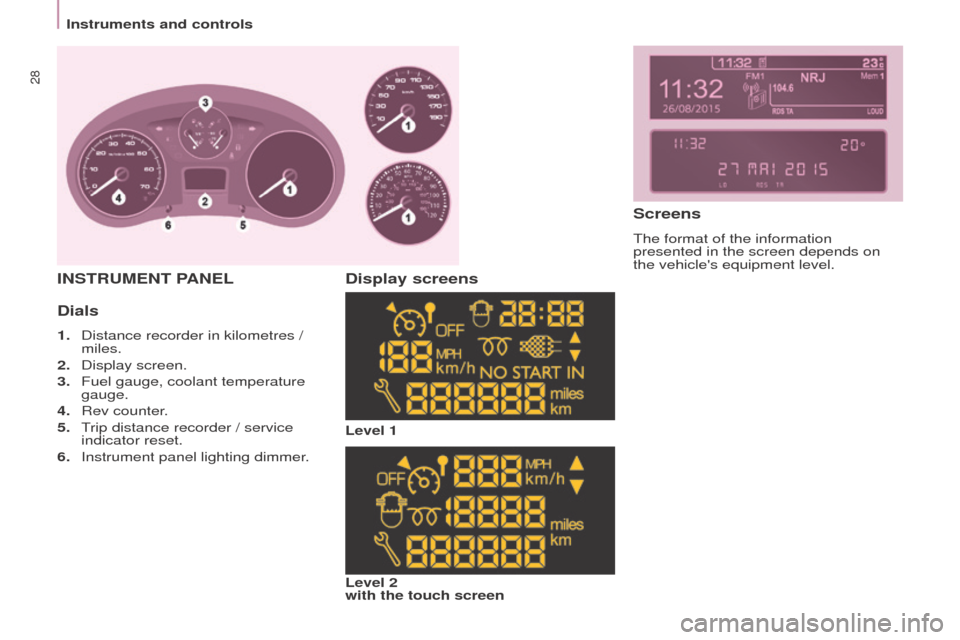
28
Instruments and controls
Partner-2-Vu_en_Chap03_Pret-a-partir_ed02-2015
INSTRUMENT PANEL
Dials
1. Distance recorder in kilometres /
miles.
2.
Display screen.
3.
Fuel gauge, coolant temperature
gauge.
4.
Rev counter
.
5.
T
rip distance recorder / service
indicator reset.
6.
Instrument panel lighting dimmer
.
Display screens
Level 1
Level 2
with the touch screen
Screens
The format of the information
presented in the screen depends on
the vehicle's equipment level.